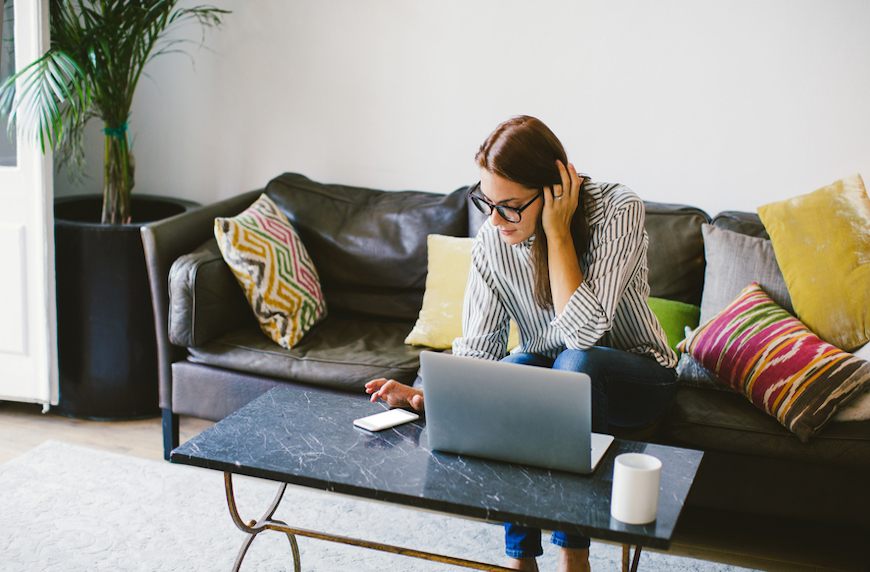
March 11, 2020 at 09:00PM by CWC
Spoiler alert: not everybody has the luxury of a home office. Not everybody even has the luxury of a desk. And while working from home certainly has its perks (working with my dog? Yes, please), it can be a challenge without a defined workspace. Temptations like Netflix loom and distracting roommates linger, which can result in productivity and motivational challenges. Not to mention, there’s just a different that comes with working in an office.
“When you commute to your office and sit at your desk all day, see people, and then commute home, you feel like you’ve ‘done’ something,” says Laura Vanderkam, author of several time management and productivity books, including Off the Clock and Juliet’s School of Possibilities. “When you work from home, you don’t have that. So you judge the day solely on what you’ve done. If that’s not much, well, that doesn’t feel so good.”
The good news is there are plenty of tips to “hack” your way into a productive work from home day. Whether it’s setting a clear schedule or taking a mid-day shower (talk about a WFH perk), these work from home tips from productivity experts that can help maximize your remote work routine.
These are the work from home tips that actually make a difference in your productivity
1. Schedule out your day
ADVERTISEMENT
ADVERTISEMENTKate Spade Autumn/Winter Sale |
Whether it’s using Google calendar or writing your to-do list down before you get to work, setting a clear schedule for your work from home day can help you stay on task.
“You’re best off setting a doable schedule for the day with specific times allocated to all the projects you intend to work on,” says Vanderkam. “Take regular breaks. Many distractions are actually evidence that your brain needs a break, and if you don’t take a real one, it will take a fake one—such as suddenly feeling the need to organize your bookshelves.”
This is also an easy way to let roommates and family members know you’re actually working. Chloe Carmichael, PhD, a clinical psychologist practicing in New York City, adds that having a clear schedule with breaks built in shows your loved ones you’re not rejecting them—you’re just trying to get your work done. “It can be a nice way to be transparent and give them a chance to support you while also setting some boundaries for yourself,” she says.
2. Set the mood
There’s plenty of research that supports the fact that our environments—from lighting to temperature to space design—affects the way we work. This doesn’t mean you need the perfect #BossBabe home office to make you feel productive. Simply shuffling your Spotify playlist can certainly do the trick.
“If you ask your Google Home to play ‘classical music for studying’ or ‘smooth jazz for the office’, you can create a little bit of an office vibe around your home,” says Dr. Carmichael. Aromatherapy works, too. Lighting candles or firing up the oil diffuser with scents like peppermint and eucalyptus can help bring clarity and focus.
And you may want to rethink wearing last night’s pajamas. “Our brains are wired up to notice patterns and signals,” says Grace Marshall, author of How to be Really Productive and productivity ninja at Think Productive. “We may not miss getting ready and commuting to work each day, but without those morning rituals, the brain can lack the signals it’s been so used to to switch between ‘home’ and ‘work’ mode—especially when both these things happen in the same place.” If putting on a blazer is what helps you feel the most focused, so be it. At the very least, brush your teeth and trade your yoga pants for a pair of jeans.
3. Recognize when you’ve hit a wall and reset
Just like in an office, it’s important to realize when you’re not feeling motivated and find a way to get back in a groove. Whether it’s taking the dog for a walk, running an errand or just unplugging for 15 minutes, figure out what helps you reset, so when you do go back to work, you’re ready to get it done.
Dr. Carmichael recommends hopping in the shower. “Sometimes taking a shower does help people to refocus and rebalance themselves a bit, ”she says. “It grips the senses, and then you’re literally refreshed.” She also suggests a physical change of scenery. Go to a local cafe or treat yourself to a working lunch at a restaurant to switch things up.
This also means defining done. If you’ve worked for eight hours and are feeling burnt out for the day, know when to call it quits. “In the office or at work, we have naturally defined finished times,” says Marshall. “At home these lines can be even more blurred. Most people find they end up working much longer hours with far less breaks when they’re in the office – which isn’t always productive.” So if it’s 6:00 and you’ve done what needed to be done for the day, shut your laptop.
4. Plan accordingly
Working from home long term looks different than a temporary situation. As Marshall mentions, the lines between work and home will continue to blur, and it’s important to maintain a sense of balance between your personal and professional lives. To help sustain healthy boundaries over the long-haul, examine your communication and availability.
“Some people find they are more responsive to messages and emails when working from home because they don’t want to be perceived as slacking off, says Marshall. “Consider setting some general communications etiquette with your colleagues. When will you check in with each other? What’s the expected response time on emails? What happens if there’s an emergency and you need to get hold of someone quickly? Hint: we don’t email the fire department when there’s a fire. Email was not designed to be an emergency communication tool.”
Long term/permanent remote work might also require lifestyle changes. If you have a family, Vanderkam suggests finding childcare accommodations, or, if you have a partner, trading off with them to work or watch the kids. She also emphasizes interaction with others. “Build in little bits of socializing,” she says. “Call with a friend, or video chat with colleagues where you talk stuff that’s not work.”
ADVERTISEMENT
ADVERTISEMENTSports Direct Free Delivery on All Orders! |
Lucky enough to have that coveted home office? Here’s how to transform it into a totally stress-free space. And if you’re really struggling to get into work mode, this hack will get your head back in the game.
Author Francesca Krempa | Well and Good
Selected by CWC

ADVERTISEMENT
ADVERTISEMENTUp to 30% off Gift Sets |







